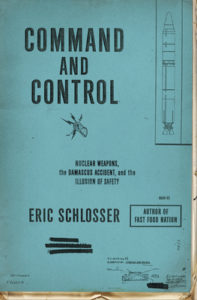 More than two decades after the end of the cold war, the threat of nuclear weapons has largely faded from public consciousness. The generation now coming of age grew up with nightmares of terrorists rather than Soviet missiles.
More than two decades after the end of the cold war, the threat of nuclear weapons has largely faded from public consciousness. The generation now coming of age grew up with nightmares of terrorists rather than Soviet missiles.
Recently, however, many Americans have been hearing about these weapons again. Highlighting many of the too many incidents where a full-scale nuclear explosion nearly happened by accident, Eric Schlosser’s new book, Command and Control: Nuclear Weapons, the Damascus Accident, and the Illusion of Safety, has attracted a good deal of well-deserved press. Schlosser, the author of Fast Food Nation, focuses most of his story on incidents that happened decades ago. Yet the reality is that we still face many—too many—of the same dangers from nuclear weapons today as we did at the height of the cold war.
When nuclear weapons are discussed nowadays, the stories focus on a terrorist group getting ahold of one or the threat that such weapons pose in the hands of countries like North Korea or Iran. Those who are slightly more tuned in might worry about the security of Russian weapons and fissile material, or the potential for a conflict between India and Pakistan to go nuclear.
When it comes to the United States, though, most tend to assume that we can rest easy. We are reassured that the U.S. nuclear arsenal is “safe, secure, and reliable.”
It is true that the United States has improved the safety and security of its nuclear weapons significantly over the years. The Titan II silo-based missiles that caused several major accidents discussed in Schlosser’s book have long since been retired. The U.S. Air Force no longer has bombers loaded with nuclear weapons flying 24 hours a day, seven days a week, as we did for too long during the cold war.
What is also true, however, is that we still have hundreds of warheads on land-based missiles on hair-trigger alert, ready to launch in minutes. So does Russia.
This high alert status, in which missiles could be launched at the first warning of an attack, increases the risk of an accidental or unauthorized launch. Developed during the era when mutually assured destruction became a fundamental truth of the cold war, it was intended to prevent a Soviet “bolt from the blue” attack from wiping out our land-based arsenal. But such an attack is no longer a realistic danger (and whether it ever was is debatable).
As Schlosser’s book demonstrates, we can’t predict when, where, and how every accident could happen. Taking our own missiles off hair-trigger alert is one of the easiest, most immediate steps we could take to make the United States safer. In that light, when President Obama announced his decision in June 2013 to update U.S. nuclear weapons policy, he directed the Pentagon to “examine and reduce the role of launch under attack in contingency planning, recognizing that the potential for a surprise, disarming nuclear attack is exceedingly remote.”
A primary motivation for changing policy is to encourage Moscow to follow suit, reducing the chances that a Russian missile could be launched accidentally or based on bad information. It would also send a signal to the rest of the world that we are serious about, as President Obama said back in 2009, “reduc[ing] the role of nuclear weapons in our national security strategy.”
The news of late has demonstrated that the arsenal is not as secure as it should be. Incidents of failed inspections at nuclear missile installations have been attributed in part to poor morale among service members. More recently, reports surfaced that missile officers had been caught leaving blast doors to the control room open while one of them was napping, violating regulations and potentially creating a security hazard. Two of the top officers responsible for nuclear weapons have also been removed from their posts over the past month amid unrelated investigations of alleged misconduct.
There have been more serious incidents as well. In 2007, a bomber that, unbeknownst to the crew, carried nuclear-armed cruise missiles, flew across the United States and sat for hours on a runway at its destination, unguarded, until workers noticed the mistake. And in 2010, a computer glitch left crews at a Minuteman intercontinental ballistic missile installation unable to communicate with 50 nuclear-tipped missiles for almost an hour, raising fears that the system had been hacked. These cases illustrate even more clearly the dangers that treating the existence of such weapons as routine can create.
In response to the 2007 incident, the Air Force said that “all evidence seems to point to this being an isolated mistake.” But this is little comfort. When it comes to nuclear weapons, an isolated mistake may be all that is needed to lead to very widespread consequences.
As Schlosser points out, ensuring nuclear weapons’ safety and security requires a complex combination of technology and people both working exactly the way that they are intended to work, every single time. While safety mechanisms can be built in, and each can compensate for the other to some degree, it is impossible to foresee every potential problem. Despite the best of planning and intentions, even a slip as small as accidentally dropping a wrench in the wrong place can set off an unpredictable series of events that can lead to serious, potentially fatal, consequences.
These slips are unavoidable. They happen every day, in all walks of life, but in most cases the stakes are not nearly so high. Schlosser says of nuclear weapons that “[e]very one of them is an accident waiting to happen.” So far, our luck has held, but there is no way to know that tomorrow won’t be the day that this changes. Now is the time to act to reduce these dangers.
